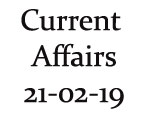-
Current Affairs 21st February 2019
Updated : 21-Feb-2019
Current Affairs 21st February 2019 - Important Points
- KALIA Chhatra Bruti scholarship for Farmers Children launched by - Odiash Government
- 7th National Photography Awards were organised in - New Delhi
- Cabinet approved National Policy on Electronics 2019 on - 19th February 2019
- Start-ups guidelines are relaxed by - Govt.
- CCEA approved ‘Kisan Urja Suraksha evam Utthaan Mahabhiyan’ Scheme for farmers’ welfare on - 19th February 2019
Current Affairs 21st February 2019 - Details
KALIA Chhatra Bruti scholarship for Farmers Children launched by - Odiash Government
The government of Odisha has released the ‘KALIA Chhatra Bruti’ scholarship for the farmer’s children. The Scholarship is under the Krushak Assistance for Livelihood & Income Augmentation- KALIA, which is a scheme for financing farmers in Odisha.
Eligibility for the Scholarship- Students should be the children of Krushak Assistance for Livelihood & Income Augmentation recipients.
- They should be learning in government professional colleges on merit basis.
- The government has released the ‘KALIA Chhatra Bruti’ program so that the children of the farmers
outshine in the future.
Krushak Assistance for Livelihood &Income Augmentation
- KALIA is a support program of Odisha whose primary goals are small farmers, cultivators & landless agricultural labourers. The features of the scheme are:
Under the Scheme, state of Odisha would spend Rupees 10180 crore over time period of 3 years until 2020-21 in delivering financial assistance to cultivators &landless agricultural labourers profiting 92 percent of the cultivators in the state & including every category from big farmers to landless cultivators. - The government would deliver Rupees 10000/family as support for cultivation, Rupees 5000 each in the Kharif & Rabi seasons, for 5 cropping seasons between 2018-19 & 2021-22.
- The financial help under the scheme is not connected to the quantum of land owned.
- The scheme also focuses landless households, specifically Schedule Caste & Schedule Tribe families.
- They will be supported with a unit cost of Rupees 12500 for events like goat rearing, mushroom farming, bee-keeping, poultry farming & fishery.
- The Scheme also delivers a life insurance cover of Rupees 2 lakh & extra personal accident coverage of the same amount for 57 lakh families.
- The Scheme also recommends interest-free crop loans up to Rupees 50000.
7th National Photography Awards were organised in - New Delhi
The 7th National Photography Awards were offered by Union Minister of State (IC) for Information &
Broadcasting Col. Rajyavardhan Rathore. The 7th edition of National Photography Awards was
organised at National Media Centre in New Delhi.
The subject for the Professional category was ‘Women-led Development’ & theme for Amateur category was ‘Fairs & Festivals of India’.
Awardees ListTotal 13 awards were offered during the ceremony.
The Lifetime Achievement Award carries a cash prize of Rupees 300000. The awards in Professional Photographer of the Year category & Amateur
Photographer of the Year category that carries cash prize of Rupees 100000 & Rupees 75000
respectively. 5 Special Mention Awards in both Professional & Amateur categories were bestowed with cash prize of Rupees 50000 & Rupees 30000 each respectively. The winner’s list is procured below:- Lifetime Achievement Award presented to Shri Ashok Dilwali.
- Professional Photographer of the Year presented to Shri SL Shanth Kumar.
- Amateur Photographer of the Year presented to Shri Gurdeep Dhiman.
- Special Mention Awards (Professional) presented to Shri Arun Sreedhar, Shri P.V. Sunderrao, Shri Kailash Mittal, Shri Mihir Singh, Ms Ranita Roy.
- Special Mention Awards (Amateur) presented to Shri V. Ravi Kumar, Ms. S. Neelima, Shri Manish Jaisi, Shri Mahesh Balasaheb Lonkar, Shri Avijit Datta.
National Photography Awards
National Photography Awards are awarded by the Photo Division under Ministry of Information &
Broadcasting. The Photo Division earlier existed as a separate Unit & now has been brought under the aegis of PIB.Start-ups guidelines are relaxed by - Govt.
The government has comforted the guidelines under the definition of Start-Ups. The deviations brought
in are as follows.
The investment limit of angel investors to pursue exemption under the Income Tax Act, 1961 has
been augmented to Rupees 25 crore from 10 Crore.
An entity shall be measured a start-up up to 10 years from its date of incorporation or registration
inspite of the earlier period of 7 years.
An entity would be measured as a start-up up to a revenue of Rupees 100 crore as against the
previous limit of Rupees 25 crore.
Exemptions Proposed
A start-up cannot capitalize in a building/land unless it is for its business/purposes of renting/held by it as stock-in-trade.
A start-up cannot offer loans/advances, other than those where lending money is portion of its
profession.
A start-up cannot make any wealth input to any other entity/invest in shares, car/mode of transport that
costs above Rupees 10 lakh.
These exclusions were brought-in to dispel the fears of CBDT that start-ups could be utilised for money
laundering/receive investment from shell corporations for tax evasion.Cabinet approved National Policy on Electronics 2019 on - 19th February 2019
The Union Cabinet on February 19th, 2019 sanctioned the National Policy on Electronics 2019- NPE 2019, planned by the Union Ministry of Electronics &Information Technology.
The 2019 Policy on Electronics proposes to drive the growth of Electronics System Design & Manufacturing industry in the nation. It swaps the National Policy of Electronics 2012.
Features of National Policy on Electronics 2019- To form eco-system for internationally competitive Electronics System Design & Manufacturing sector by encouraging domestic production & export in the complete value-chain of Electronics System Design & Manufacturing.
- To issue incentives & support for production of core electronic mechanisms.
- To deliver special incentive packages for jumbo projects that are extremely high-tech & involve huge funds, including semiconductor services, display fabrication, and many more.
- To frame suitable schemes & incentive mechanisms to inspire new units & expansion of existing units.
- To promote Industry-led Research & Development & innovation in all sub-sectors of electronics including 5G, Internet of Things, Artificial Intelligence, Machine Learning, Drones, Robotics, Additive Manufacturing, Photonics, Nano-based devices and many more.
- To deliver incentives &support for suggestively enhancing availability of expert manpower.
- Special drive on Fabless Chip Design Industry, Medical Electronic Devices Industry, Locomotive Electronics Industry &Power Electronics for Mobility & Strategic Electronics Industry.
- To create Sovereign Patent Fund to encourage the progress &achievement of IPs in Electronics System Design & Manufacturing sector.
CCEA approved ‘Kisan Urja Suraksha evam Utthaan Mahabhiyan’ Scheme for farmers’ welfare on - 19th February 2019
The Cabinet Committee on Economic Affairs, led by PM Narendra Modi, on February 19th, 2019 sanctioned the release of “Kisan Urja Suraksha evam Utthaan Mahabhiyan” with the aim of providing financial & water security to farmers.
Components of scheme
The Kisan Urja Suraksha evam Utthaan Mahabhiyan scheme consists of 3 components:
1. Component-A: 10000 megawatts of De-centralised Ground Mounted Grid linked Renewable Power
Plants.
2. Component-B: Installation of 17.50 lakh separate Solar Powered Agriculture Pumps.
3. Component-C: Solarisation of 10 Lakh Grid-linked Solar Powered Agriculture Pumps.
With all these 3 components united, the scheme goals to improve a solar capacity of 25750 megawatts by 2022.
Impact
The Scheme will have considerable environmental influence in terms of savings of CO2 emissions. All 3
components of the Scheme will save around 27 million tonnes of CO2 emission/year.
The Component-B of the Scheme on separate solar pumps may result in saving of 1.2 billion litters of diesel/year &related savings in the foreign exchange due to decrease of import of crude oil.
The scheme will have straight employment latent. In addition to increasing self-employment, it will produce employment prospect equivalent to 6.31 lakh job/year for both skilled as well as unskilled workers.














